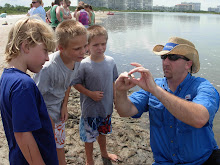Recently there have been reports of red snapper with lesions and other signs of stress thought to be related to last year's Deepwater Horizon oil spill. Although researchers have indicated the infections are associated with a chronic exposure to a toxin, they have stopped short of saying it was caused directly by the oil although it is thought that it's likely to be the culprit. To see the whole article visit: http://www.tampabay.com/news/environment/wildlife/sick-fish-suggest-oil-spill-still-affecting-gulf/1164042
While there have certainly been cases such as the ones described above, seafood samples in the thousands from the Gulf continues to pass sensory and analytical testing declaring it safe to eat. Just as an FYI even if a fish with lesions were caught for commercial purposes, it is highly unlikely it would make it to the market because of 1) the quality of such a product, and more importantly 2) because of the seafood industry's HACCP program. According to the International HACCP Allicance, HACCP or Hazard Analysis Critical Control Point "is a process control system that identifies where hazards might occur in the food production process and puts into place stringent actions to take to prevent the hazards from occurring. By strictly monitoring and controlling each step of the process, there is less chance for hazards to occur. HACCP is important because it prioritizes and controls potential hazards in food production. By controlling major food risks, such as microbiological, chemical and physical contaminants, the industry can better assure consumers that its products are as safe as good science and technology allows. By reducing foodborne hazards, public health protection is strengthened."
All primary and secondary seafood processors in the U.S as well as processors who import seafood to the U.S. are required by law to have HACCP plans in place for their products. They are also required to update their plans annually and/or when they have any changes to the way the process their products.
Despite the article I just mentioned, I also wanted to share with you the findings from a report that recently came out from the Alabama Marine Resource Division (Drs. Sean P. Powers and Robert L. Shipp) and the Department of Marine Sciences, University of South Alabama and the Dauphin Island Sea Lab as an example of the kind of systematic sampling that is being done to ensure Gulf seafood is and remains safe.
Purpose:
To provide a brief synopsis of fishery independent data to assess whether diseased reef fish are present in the population.
Summary: Based on our fishery independent sampling, we found no significant evidence of
diseased fish (noted by external sores or visible disfigurement of internal organs) in reef fish populations off Alabama or the western Florida Panhandle.
Synopsis of methodology: Extensive fishery independent sampling conducted by USA and DISL occurred from Jan 2010 – April 2011. Multiple gears are used in the surveys including underwater video recorded via a ROV, vertical or “bandit” longlines, bottom longlines, bottom trawls and traditional hook and line gear. Site selection is based on a completely random and unbiased design. In addition a limited number of fishery dependent (port sampling) data were collected. Approximately 2300 economically important fish (primarily red snapper, gray trigger fish, gag grouper, scamp) have been collected in coastal Alabama and the western panhandle of Florida out to 300 ft depths. Three types of visual examinations were conducted on fish:
external examination for sores, lesions or skin abnormalities (all fish); gross anatomical examination of internal organs (all fish, this analysis would detect organ disfigurement or enlargement); and detailed internal examination of organs (approximately 310 fish, this analysis would detect small lesions, or discoloration of organs). No sores, lesions or disfigurement were noted in the external examination or gross anatomical examination. Two cases of possible liver abnormalities were noted. In both of these cases, there were faint “spots” on the liver.
Friday, April 29, 2011
Subscribe to:
Post Comments (Atom)








No comments:
Post a Comment